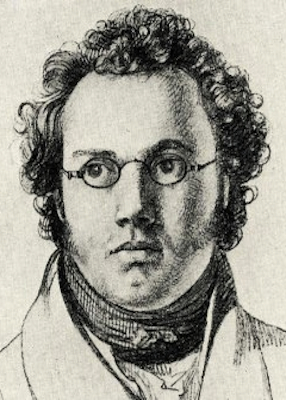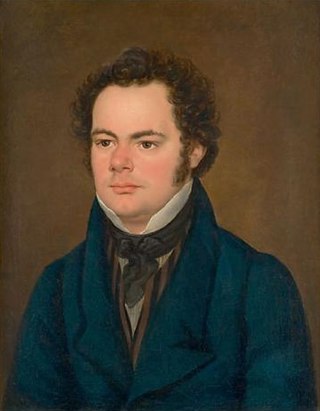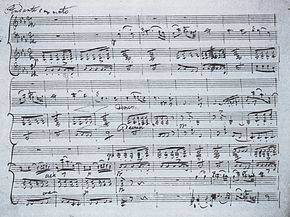The sonata form is a musical structure generally consisting of three main sections: an exposition, a development, and a recapitulation. It has been used widely since the middle of the 18th century.

The Trout Quintet (Forellenquintett) is the popular name for the Piano Quintet in A major, D. 667, by Franz Schubert. The piano quintet was composed in 1819, when he was 22 years old; it was not published, however, until 1829, a year after his death.

The Piano Quintet in E-flat major, Op. 44, by Robert Schumann was composed in 1842 and received its first public performance the following year. Noted for its "extroverted, exuberant" character, Schumann's piano quintet is considered one of his finest compositions and a major work of nineteenth-century chamber music. Composed for piano and string quartet, the work revolutionized the instrumentation and musical character of the piano quintet and established it as a quintessentially Romantic genre.
The Piano Quintet in F minor, Op. 34, by Johannes Brahms was completed during the summer of 1864 and published in 1865. It was dedicated to Her Royal Highness Princess Anna of Hesse. As with most piano quintets composed after Robert Schumann's Piano Quintet (1842), it is written for piano and string quartet.
Sonata rondo form is a musical form often used during the Classical and Romantic music eras. As the name implies, it is a blend of sonata and rondo forms.
Cyclic form is a technique of musical construction, involving multiple sections or movements, in which a theme, melody, or thematic material occurs in more than one movement as a unifying device. Sometimes a theme may occur at the beginning and end ; other times a theme occurs in a different guise in every part.

Franz Schubert's Symphony No. 8 in B minor, D. 759, commonly known as the Unfinished Symphony, is a musical composition that Schubert started in 1822 but left with only two movements—though he lived for another six years. A scherzo, nearly completed in piano score but with only two pages orchestrated, also survives.

The Cello Sonata No. 3 in A major, Op. 69, is the third of five cello sonatas by Ludwig van Beethoven. He composed it in 1807–08, during his productive middle period. It was first performed in 1809 by cellist Nikolaus Kraft and pianist Dorothea von Ertmann, a student of Beethoven. Published by Breitkopf & Härtel the same year, it was dedicated to Freiherr Ignaz von Gleichenstein, Beethoven's friend and an amateur cellist. The sonata was successful with audiences from the beginning.

Franz Schubert's final chamber work, the String Quintet in C major is sometimes called the "Cello Quintet" because it is scored for a standard string quartet plus an extra cello instead of the extra viola which is more usual in conventional string quintets. It was composed in 1828 and completed just two months before the composer's death. The first public performance of the piece did not occur until 1850, and publication occurred three years later in 1853. Schubert's only full-fledged string quintet, it has been praised as "sublime" or "extraordinary" and as possessing "bottomless pathos," and is generally regarded as Schubert's finest chamber work as well as one of the greatest compositions in all chamber music.

The Trio No. 1 in B-flat major for piano, violin, and cello, D. 898, was written by Franz Schubert in 1827. The composer finished the work in 1828, in the last year of his life. It was published in 1836 as Opus 99, eight years after the composer's death. Like the E-flat major trio, it is an unusually large scale work for piano trio, taking around 40 minutes in total to perform.
The Piano Sonata in A minor D. 845 (Op.42) by Franz Schubert is a sonata for solo piano. Composed in May 1825 and entitled Premiere Grande Sonata, it is the first of three sonatas published during the composer's lifetime, the others being D.850 and D.894. Conceived as a set, these works were composed during what was reportedly a period of relatively good health and spirits for Schubert and are praised for their quality and ambition. This first sonata in particular marks a significant step toward the composer’s mature piano sonata style; the format and several characteristic stylistic elements continue through the last.
The Piano Sonata in G major D. 894, Op. 78 by Franz Schubert is a sonata for solo piano, completed in October 1826. The work is sometimes called the "Fantasie", a title which the publisher Tobias Haslinger, rather than Schubert, gave to the first movement of the work. It was the last of Schubert's sonatas published during his lifetime, and was later described by Robert Schumann as the "most perfect in form and conception" of any of Schubert's sonatas. A typical performance runs approximately 35 minutes.

Franz Schubert's last three piano sonatas, D 958, 959 and 960, are his last major compositions for solo piano. They were written during the last months of his life, between the spring and autumn of 1828, but were not published until about ten years after his death, in 1838–39. Like the rest of Schubert's piano sonatas, they were mostly neglected in the 19th century. By the late 20th century, however, public and critical opinion had changed, and these sonatas are now considered among the most important of the composer's mature masterpieces. They are part of the core piano repertoire, appearing regularly on concert programs and recordings.
The Piano Sonata in E major, D 157 is a piano sonata with three movements composed by Franz Schubert in February 1815. The Allegro D 154 is an early version of its first movement.
String Quintet No. 2 in G major, Op. 111, is a work by Johannes Brahms composed in 1890 and published in 1891. It is known as the Prater Quintet. Brahms intended it to be his last piece of music, though he later produced a number of piano pieces and the two sonatas for clarinet or viola and piano. The first performance of the Quintet in Vienna on November 11, 1890 was a sensation.
Brian Newbould is an English composer, conductor and author who has conjecturally completed Franz Schubert's Symphonies D 708A in D major, No. 7 in E major, No. 8 in B minor ("Unfinished"), No. 10 ("Last") in D major, Piano Sonata in C major, D 840, Quartettsatz, D. 703 and String Trio, D. 471. He was educated at Gravesend Grammar School, and earned a BMus degree with top honors from the University of Bristol.
Sonatas, duos and fantasies by Franz Schubert include all works for solo piano by Franz Schubert, except separate dances. They also include a number of works for two players: piano four hands, or piano and a string instrument.

The Piano Sonata in B minor, Op.5, was written by Richard Strauss in 1880–81. The Sonata is in the Romantic style of his teenage years. The first recording of the piece was the last recording made by the Canadian pianist Glenn Gould.

The Impromptus, Op. 90, D. 899, are a set of four impromptus for solo piano composed by Franz Schubert in 1827. They were written in the same year as the Impromptus, Op. 142, though only the first two pieces were published during Schubert's lifetime. Together with the latter set, they have become a cornerstone of the piano repertoire.

The Impromptus, Op. posth. 142, D. 935, are a set of four impromptus for solo piano composed by Franz Schubert in 1827. They were written in the same year as the Impromptus, Op. 90, but were not published until 1839, more than a decade after his death. Together with the preceding set, they have become a cornerstone of the piano repertoire.









